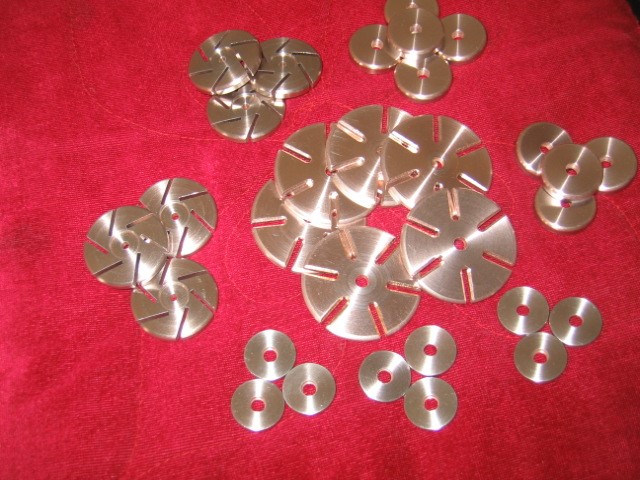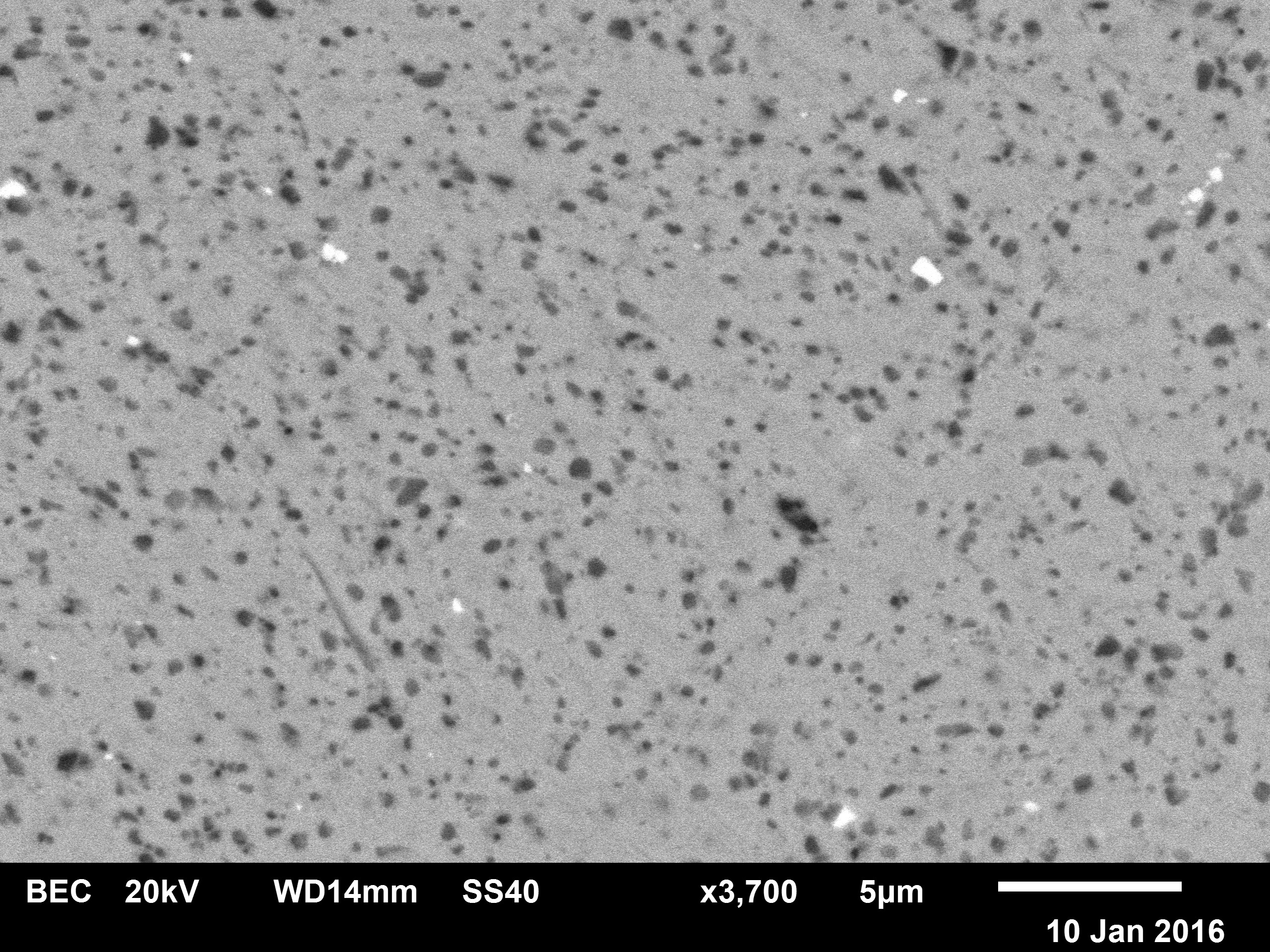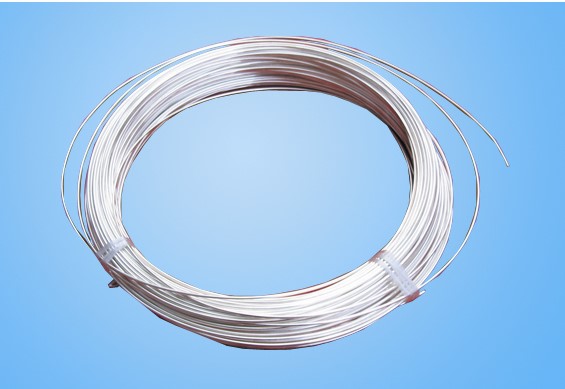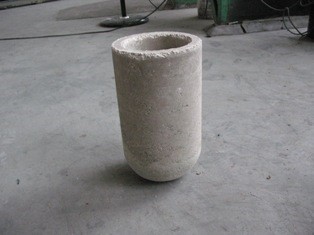Research Achievement in New Type of Materials and Their Manufacture Technology
Dr. Prof. Yaping Wang’s research activities focus on the construction of creative scientific ideas and the direct utilization in industrial practice. He invented or developed several new types of materials and their manufacturing technology, some of which have been utilized in large scale and some are being transformed to industrial production. The following lists some products Dr. Wang group developed in the field of Cu, Ag and Al based materials.
I. Copper Alloys
I.I CuCr system contact materials

Our group partially led the development of the industrial technology for CuCr contact materials during the past two decades. The largest company in the world was established on the basis of our first generation technology for CuCr50 contact materials. In 2002 our group invented the second generation technology, vacuum smelting, to produce CuCr25 contact materials. In 2012, we invented the third generation technology, vacuum infiltration technology to produce CuCr materials with low Cr content. Currently the second generation technology we invented is still the dominant method in the world and the vacuum infiltration technology to produce CuCr25 materials have began to use in large scale in China.
I.II Copper alloys with high strength and high conductivity

Copper alloys were usually manufactured in large scale by induction melting, which is very difficult to be used to produce copper alloys containing active elements. The mass production technology for the copper alloys with active elements, like Zr-bronze, Cr-bronze, CrZr-bronze, was controlled in a few international big company, which has to manufacture the bronze with complex process and relative high cost. Our group developed a simple short process to produce the bronze with cheaper equipments. In our laboratory furnace, more than 500 kg ingot could be achieved for one time. There are higher properties of our products than those shipped to China. There exist no pores or looseness in our products for the different solidification process. The new technology is expect to realize industrial production in the near future.
I.III Elastic copper alloys to replace toxic Be-bronze

Although Be-Cu alloys are harmful to the operators' health during production and utilization processes, they have to be widely used in industry for their superior strength and elastic properties. Ti bronze, with similar properties as Be-Cu alloys, could not be widely manufactured because of the technological difficulty of Ti reaction with nearly all crucibles in conventional vacuum induction melting production. By the similar technology as that developed for CrZr-bronze, Ti-bronze was also successfully manufactured in the laboratory pilot scale.
I.IV Cu/Al2O3 electrode materials


Oxide dispersion strengthened copper materials were currently manufactured by internal oxidation method, which is a very expensive and complex process. Our group breaks the limitation of the strengthening method based on the precipitation strengthening and dispersion strengthening in Cu matrix materials and puts forward a completely different idea, i.e. "skeleton reinforcement", strengthening copper matrix with alumina network. The strength and life of the Cu-copper based materials are much higher than those of the conventional Cu based composites. The technology to manufacture the new type of Cu-A1203 composites is similar to that of CuCr materials, includes infiltrating the Cu melt into the A1203 pre-forming skeleton. The whole process is simpler and costs less than that of internal oxidation.
II. Silver Based Materials
II. I AgSnO2 contact Materials


Under the sponsor of national 863 project, "Technology Development of New Type of Electrical Contacts and Their Industrial Applications (No. 2001AA320714)", the nanocomposite AgSnO2 contact materials were developed by our group and realized large-scale industrial production by the cooperation of two enterprises, Shenyang Zhongji Co. Ltd. and Shenyang Jinna Co., Ltd. The project were further sponsored by the National Development and Reform Commission. We also took part in the setting of the national standard (GB/T20235-2006, the technical conditions for silver tin oxide electrical contact materials).
II. I Silver-Saving Silver Based Materials

SnO2 content in the traditional AgSnO2 contacts is very low, not more than 15 wt%, because of the limitation of current manufacturing method, which induces low arc erosion resistance so that the AgSnO2 contacts cannot be used in high current apparatus. AgSnO2 electrical contacts with SnO2 content as high as 45% were developed in our group by the addition of other oxide component, so we solve the manufacturing problem of the AgSnO2 contact materials with high SnO2 content. The composition of the AgSnO2 contacts with high SnO2 content was optimized and a type of AgSnO2 contacts with extremely high arc erosion resistance and stability of contact resistance during arcing is able to be used in the high current apparatus. The high SnO2 content AgSnO2 contacts are expected to be industrially produced in the near future.
III. SiAl Electronic Packaging Materials.

Si-Al alloys are attractive electronic packaging materials due to their low thermal expansion coefficient, high thermal conductivity and low density. However, under conventional solidification conditions, high Si content usually leads to the formation of coarse primary Si phases which seriously reduces the workability and forms local impediment for thermal conduction. Spray deposition technology has to be industrial applied to produce Si-Al alloys although there might exist gas pores and high cost problem. We use the infiltration technology developed from CuCr contact materials, including infiltrating the Al melt into the Si skeleton, successfully produce the SiAl materials. The whole process is simple and costs less than that of spray forming technology.
IV. CaO crucible:

CaO is a kind of materials with lowest Gibbs free energy but easily hydration in air so that it is difficult to prepare and keep. we develop the manufacture technology for CaO crucible with high hydration resistance and with very simple equipments. The CaO crucible could be used in the vacuum smelting of alloys requiring high purity and low pollution of S, P, O, et al.
Personal Information
Education Experience
June 1998, Ph.D. (Material Science): Xi’an Jiaotong University, Xi’an.
July 1994, M.Sc. (Material Science): Xi’an Jiaotong University, Xi’an.
July 1991, B.Sc. (Material Science): Xi’an Jiaotong University, Xi’an.
Research Experience
July 2006 – Present: Professor (Doctorial Supervisor) Xi’an Jiaotong University
April 2014 - July 2014 Visiting Scholar, Kettering University, USA
December 2010 - December 2011 Visiting Scholar,
April 2002 – June 2006: Associate research fellow, Institute of Metal Research, CAS
July 2000 – April 2002: Associate professor, Xi’an Jiaotong University, China
June1998 - June 2000: Post-doctoral fellow, Institute of Metal Research, China
Awards
Shaanxi Province Science and Technology Award, Second Class, 2010 (First winner)
State Science and Technology Advancement Award, Second Class, 2007 (Third winner)
New Century Excellent Talents, Ministry of Education of China, 2007
Shaanxi Province Science and Technology Award, First Class, 2006 (Third winner)
Responsible Projects Funder by Chinese Government
1. Arc erosion of high SnO2 content Ag-based contact materials prepared by laser directly deposition (National Natural Science Foundation of China: 51171146, 2012~2015)
2. Abnormal behaviors of vacuum arc over the nanostructured electrode materials (Key project of Natural Science Basic Research plan in Shaanxi Province of China, 2009~2011)
3. Mechanism of the peculiar behavior of arc over the amorphous and nanostructured electrode materials (National Natural Science Foundation of China: 50871078, 2008~2010)
4. Local work function and field emission behavior of bulk amorphous alloys (National Natural Science Foundation of China: 50271950, 2003~2005)
5. Research and development of new type electric contact material and its industrial application(National High Technology Research and Development Program of China: 2001AA320714, 2002-2005)
Publications List (* corresponding author)
1. Yaping Wang, Zhimao Yang, Bingjun Ding and Jingen Zhou, “The effect of electrode materials and additives on the breakdown strength of a vacuum gap,” IEEE Trans. on DEI, 5(2), 1998: 245-249
2. Yaping Wang and Bingjun Ding, “The preparation and the properties of microcrystalline and nanocrystalline CuCr contact materials,” IEEE Trans. on CPT, 22(3), 1999: 467-472
3. Yaping Wang and Ke Lu, “Electrical resistance measurement of crystallization kinetics of amorphous Ni80P20 alloy,” Z. Metallkd, 91(4), 2000: 285-290
4. Yaping Wang and Ke Lu, “Accurate electrical resistance measurement of the crystallization kinetics of amorphous alloys,” Science in China, Ser E 44(1), 2001: 33-41
5. Yaping Wang and Ke Lu, “Electrical resistance study of glass transition and crystallization characteristics of Zr-Al-Cu-Ni metallic glasses,” J. Mater. Sci. Tech. 18, 2002: 492-496
6. Yaping Wang, Chengyu Zhang, Hui Zhang, Bingjun Ding and Ke Lu, “Effect of the microstructure of electrode materials on arc cathode spot dynamics,” J. Phys. D: Appl. Phys. 36, 2003: 2649-2654
7. Yanli Chang, Wei Zheng, Yuxiang Zhai, Yaping Wang*, "Preparation and Performance of CuCr Contact Materials for Vacuum Switches with Low Contact Pressure," Journal of Electronic Materials, 45(11), 2016: 5647-5654
8. Xueliang Wang, Junjun Li, Yaping Wang*, "Improved high temperature strength of Copper-Graphene Composite Material," Mater. Lett. 181, 2016: 309-312
9. Yanli Chang, Zhiming Zhou, Ziqin Guo, Yaping Wang*, "Ductile Chromium in Heavily Cold-Drawn Cu75Cr25 Alloy," Metall. Mater. Trans. A 47(1), 2016: 504-509.
10. Bi Fu, Xuan Zhou, Yaping Wang*, "High-rate performance electrospun Na0.44MnO2 nanofibers as cathode material for sodium-ion batteries," Journal of Power Sources, 310, 2016: 102-108.
11. Bi Fu, Xuan Zhou, Yaping Wang*, "Co3O4 carbon nanofiber mats as negative electrodes for sodium-ion batteries," Mater. Lett., 170, 2016: 21-24.
12. Bi Fu, YaodongYang*, Kun Gao and Yaping Wang*, "Significant increase of TC and large piezoelectriccoefficient in Ba(Ti0.80Zr0.20)O3-0.5(Ba0.70Ca0.30)TiO3 nanofibers," Appl. Phys. Lett. 107, 2015: 042903
13. Bi Fu, Ruie Lu, Kun Gao, Yaodong Yang* and Yaping Wang*, "Magnetoelectric coupling in multiferroic BaTiO3-CoFe2O4 composite nanofiber via electrospinning." Europhysics Lett.111, 2015: 17007.
14. Bi Fu, Ruie Lu, Kun Gao, Yaodong Yang* and Yaping Wang*, "Substrate clamping effect onto magnetoelectric coupling in multiferroic BaTiO3-CoFe2O4 core-shell nanofibers via coaxial electrospinning," Europhysics Lett. 112, 2015: 27002.
15. Bi Fu, Ruie Lu, Miao Liu, Kun Gao,Yigang Tong, Xuan Zhou, Baolin Guo, Yaodong Yang*, Yaping Wang*, "Variation of local piezoelectricity in multiferroic CoFe2O4-Pb(Zr0.3Ti0.7)O3 composite nanofibers." Mater. Lett.157, 2015: 311-314.
16. Bi Fu, Yigang Tong, Xuan Zhou*, Prem Vaishnava and Yaping Wang*, "Fe3O4 Hollow Mesocrystal for Advanced Energy Storage." Battery Congress 2015.
17. Jun Wang, Shengnian Tie, Yaping Wang*, "Contact resistance characteristics of Ag-SnO2 contact materials with high SnO2 content," J Alloy Compd. 644, 2015: 438-443.
18. Zhou Z M, Zhou T, Chai L Ja,Tu J,Yaping Wang, Huang WJ, Xiao HM, Xiao ZP, "Microstructure and liquid phase separation of CuCr alloys treated by high current pulsed electron beam," Mater. Res. DOI: http://dx.doi.org/10.1590/1516-1439.323714, 2015
19. Yongli Guo, Zhibin Zhou and Yaping Wang*, "Preparation, electrical contact performance and arc-erosion behavior of Cu/La2NiO4 composites," 3rd International Conference on Material, Mechanical and Manufacturing Engineering (IC3ME 2015)
20. Yigang Tong, Bi Fu, Xuan Zhou* and Yaping Wang, "Graphene Composite for Advanced Energy Storage." Battery Congress 2015.
21. Chai L J, Zhou Z M*, Xiao Z P, Tu J, Yaping Wang, “Evolution of surface microstructure of Cu-50Cr alloy treated by high current pulsed electron beam,” Sci. China –Tech. Sci. 2015, 58(3), : 462-469
22. Zhou Z M*, Xiao, H M, Huang W J, Tu J, Chen Y F, Xiao Z P, Luo T X, Yaping Wang, “Surface Modification of Cucr25 Alloy with Cr Coatings Treated by High Current Pulsed Electron Beam,” AASRI Inter. Conf. on Indust. Electr. and Appl. London, ENGLAND, 2015
23. Zhou Z M*, Liu J, Huang W J, Hu J J, Tang L W, Wei B W, Yang B, Yaping Wang, “Microstructures of CuCr50 alloys by high current pulsed electron beam,” Inter. confer. On Auto. Mech. & Electrical Engineering, Phuket, Thailand, 2015: 520-525
24. Jun Wang, Xuan Zhou, Lin Lu, Dongmei Li, Pravansu Mohanty*, Yaping Wang*. "Microstructure and properties of Ag-SnO2 coatings prepared by cold spraying," Surf. Coating Technol. 236 (2013) 224-229.
25. Jun Wang, Dongmei Li, Yaping Wang*, "Microstructure and properties of Ag-SnO2 materials with high SnO2 content," J. Alloy Compd. 2014, 582: 1-5.
26. Jun Wang, Wei Liu, Yaping Wang*, "The behavior and effect of CuO in Ag-SnO2 materials," J. Alloy Compd. 2014, 588: 378-383.
27. Xuan Zhou, N Moroz, Pravansu Mohanty, Fu Bi, Yaping Wang, B C Satishkumar*, "Microstructure effects on electrochemical characteristics for plasma spray deposited LiFePO4 Films," J. Coating Sci. Technol. 2014, 1: 17-24.
28. Hui Cai, Dongde Tong, Yaping Wang*, Xiaoping Song and Bingjun Ding, “Reactive synthesis of porous Cu3Si compound,” J Alloy Compd, 2011, 509(5): 1672-1676
29. Hui Cai, Yaping Wang*, Xiaoping Song and Bingjun Ding, “Phase composition, microstructure and thermal diffusivity of Cu/Si composites sintering temperature dependence,” Adv Mater Res, 2011, 275:200-203
30. Zhiming Zhou, Jianrong Gao, Feng Li, Yaping Wang, M Kolbe, “Experimental determination and thermodynamic modeling of phase equilibria in the Cu–Cr system,” J Mater Sci, 2011, 46: 7039–7045
31. Fei Wang, Yaping Wang*, “Microstructure Evolution of a Fine Grain Al-50wt%Si alloy Fabricated by High Energy Milling,” Key Eng. Mater. 2011, 479: 54-61
32. Hui Cai, Debao Tong, Yaping Wang*, Xiaoping Song and Bingjun Ding, “Novel Cu/Si composites: A sol-gel-derived Al2O3 film as barrier to control interfacial reaction,” J. Mater. Res, 25(11), 2010: 2238-2244
33. Liu Y W, Zhang C Y, Qiao S R, Wen H, Yang Z M and Yaping Wang, Characteristics of arc erosion for Cu-C composite materials in air,” Modern Physics Letters B, 23(27), 2009: 3281-3287
34. Zhou Z M, Gao J R, Li F, Zhang Y K, Yaping Wang and Kolbe M, “On the metastable miscibility gap in liquid Cu-Cr alloys”, J.Mater. Sci. 44, 2009: 3793-3799
35. Qibin Ye and Yaping Wang*, “Redistribution of SnO2 particles in Ag/SnO2 materials during rapid solidification,” Mater. Sci. Eng. A449-451, 2007: 1045-1048.
36. Yang S C, Yaping Wang, Wang Q F, Zhang R L and Ding B J, “UV irradiation induced formation of Au nanoparticles at room temperature: The case of pH values,” Colloids Surf., A 301(1-3), 2007: 174-183
37. Yang S C, Yaping Wang, Wang Q F, Zhang R L, Yang Z M, Guo Y and Ding B J, “Growth of Gold Nanoplates: The Case of a Self-Repair Mechanism,” Cryst. Growth Des. 7(11), 2007: 2258-2261
38. Yang S C, Zhang R L, Wang Q F,Ding B J, Yaping Wang, “Coral-shaped 3D assemblies of gold nuclei induced by UV irradiation and its disintegration,” Colloids Surf., A 311(1-3), 2007: 174-179
39. Gao J, Yaping Wang, Zhou Z M and Kolbe M, “Phase separation in undercooled Cu–Cr melts,” Mater. Sci. Eng. A.449-451, 2007: 654-657
40. Zhang C Y, Yang Z M, Yaping Wang, Ding B J, Guo Y, “Preparation of CuCr25 contact materials by vacuum induction melting,” J Mater. Proc. Tech., 178, 2006 : 283-286
41. Jiang P, Li F and Yaping Wang, “Effect of different types of carbon on icrostructure and arcing behavior of Ag/C contact materials,” IEEE Trans. CPT. A 29(2), 2006: 420-423
42. Zhang C Y, Yang Z M, Yaping Wang, Ding B J, “Properties of nanocrystalline CuCr50 contact material,” Advanc. Eng. Mater., 7, 2005: 1114-1117
43. Zhou Z M, Yaping Wang,Gao J and Kolbe M, “Microstructure of rapidly solidified Cu-25 wt.% Cr alloys,” Mater. Sci. Eng. A398 (2005) 318-322
44. Luo Q F, Yaping Wang and Ding B J, “Microstructure and arc erosion characteristics of Ag/Ni contacts by mechanical alloying,” IEEE Trans. CPT. A 28, 2005: 785-788
45. Zhang C Y, Yaping Wang, Yang Z M, Guo Y and Ding B J, “Microstructure and properties of vacuum induction melted CuCr25 alloys,” J. Alloys & Compds. 366, 2004: 289-292
46. Zhang C Y, Yaping Wang, Yang Z M, Ding B J and Li Y L, “Microstructure and properties of CuCr25 alloys with different Ni content,” Acta Metallurgica Sinica, 16(2), 2003: 151-154
47. Zhuge F, Ye Z Z, Wang F Z, Yaping Wang, Zhang H, Ding B J, “Nanocomposite W-4.5%ThO2 thermionic cathode,” Mater. Lett., 57, 2003 : 2776-2779
48. Cao H, Yaping Wang, Zheng Z and Xian A P, Properties of CuCr contact materials with low chromium content and fine particles. Transactions of Nonferrous Metals Society of China.13(2003) 930-932
49. Zhang C Y, Yang Z M, Yaping Wang and Ding B J, “A worm-like trace of cathode spots on Cu-Zr-Ti amorphous ribbons,” J. Phys. D: Appl. Phys. 36(2003) 2276-2280.
50. Zhang C Y, Yang Z M, Yaping Wang and Ding B J, “Cathode spot propagation on the surface of amorphous, nanocrystalline and crystalline Cu60Zr28Ti12 cathodes, ” Phys. Lett. A, 318(2003) 435-439.
51. Ding B J, Yaping Wang, Yang Z M, Ni S L, Wang C L, Cui W and Chen J P, "The influence of electrode materials on late discharges in vacuum switching devices," IEEE Trans. on DEI, 6(6), 1999: 913-915
Books
1. Yaping Wang in: Strategic Research Report, National Nature Science Foundation of
2. Yaping Wang, Preparation and Forming of Materials, Xi'an Jiaotong University, 2007
3. Yaping Wang in: Bingjun Ding, Y P Wang et al, Nanostructured Materials, Chpt 7 and Section 2,

 (创新港)
(创新港)


